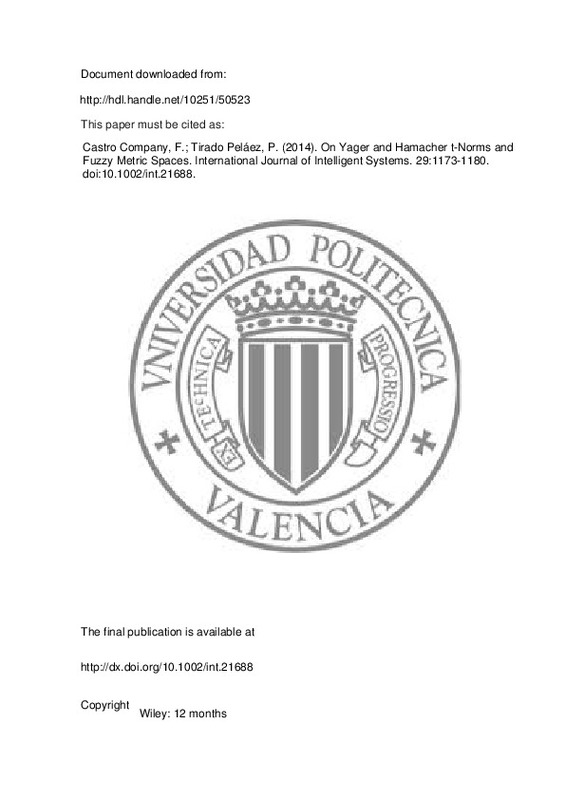JavaScript is disabled for your browser. Some features of this site may not work without it.
Buscar en RiuNet
Listar
Mi cuenta
Estadísticas
Ayuda RiuNet
Admin. UPV
On Yager and Hamacher t-Norms and Fuzzy Metric Spaces
Mostrar el registro sencillo del ítem
Ficheros en el ítem
| dc.contributor.author | Castro Company, Francisco
|
es_ES |
| dc.contributor.author | Tirado Peláez, Pedro
|
es_ES |
| dc.date.accessioned | 2015-05-19T18:03:47Z | |
| dc.date.available | 2015-05-19T18:03:47Z | |
| dc.date.issued | 2014-12 | |
| dc.identifier.issn | 0884-8173 | |
| dc.identifier.uri | http://hdl.handle.net/10251/50523 | |
| dc.description.abstract | Recently, Gregori et al. have discussed (Fuzzy Sets Syst 2011;161:2193 2205) the so-called strong fuzzy metrics when looking for a class of completable fuzzy metric spaces in the sense of George and Veeramani and state the question of finding a non-strong fuzzy metric space for a continuous t-norm different from the minimum. Later on, Gutíerrez-García and Romaguera solved this question (Fuzzy Sets Syst 2011;162:91 93) by means of two examples for the product and the Lukasiewicz t-norm, respectively. In this direction, they posed to find further examples of nonstrong fuzzy metrics for continuous t-norms that are greater than the product but different from minimum. In this paper, we found an example of this kind. On the other hand, Tirado established (Fixed Point Theory 2012;13:273 283) a fixed-point theorem in fuzzy metric spaces, which was successfully used to prove the existence and uniqueness of solution for the recurrence equation associated with the probabilistic divide and conquer algorithms. Here, we generalize this result by using a class of continuous t-norms known as ω-Yager t-norms. | es_ES |
| dc.description.sponsorship | The second author acknowledges the support of the Ministry of Economy and Competitiveness of Spain under grant MTM2012-37894-C02-01 and the support of Universitat Politecnica de Valencia under grant PAID-06-12-SP20120471. | en_EN |
| dc.language | Inglés | es_ES |
| dc.publisher | Wiley: 12 months | es_ES |
| dc.relation.ispartof | International Journal of Intelligent Systems | es_ES |
| dc.rights | Reserva de todos los derechos | es_ES |
| dc.subject | T-norm | es_ES |
| dc.subject | Yager t-norms | es_ES |
| dc.subject | Hamacher t-norms | es_ES |
| dc.subject | Fuzzy Metric Spaces | es_ES |
| dc.subject.classification | MATEMATICA APLICADA | es_ES |
| dc.title | On Yager and Hamacher t-Norms and Fuzzy Metric Spaces | es_ES |
| dc.type | Artículo | es_ES |
| dc.identifier.doi | 10.1002/int.21688 | |
| dc.relation.projectID | info:eu-repo/grantAgreement/UPV//PAID-06-12-SP20120471/ | es_ES |
| dc.relation.projectID | info:eu-repo/grantAgreement/MINECO//MTM2012-37894-C02-01/ES/METODOS TOPOLOGICOS EN HIPERESPACIOS Y MULTIFUNCIONES CONTRACTIVAS. CASI-METRICAS Y DOMINIOS CUANTITATIVOS/ | es_ES |
| dc.rights.accessRights | Abierto | es_ES |
| dc.contributor.affiliation | Universitat Politècnica de València. Departamento de Matemática Aplicada - Departament de Matemàtica Aplicada | es_ES |
| dc.description.bibliographicCitation | Castro Company, F.; Tirado Peláez, P. (2014). On Yager and Hamacher t-Norms and Fuzzy Metric Spaces. International Journal of Intelligent Systems. 29:1173-1180. https://doi.org/10.1002/int.21688 | es_ES |
| dc.description.accrualMethod | S | es_ES |
| dc.relation.publisherversion | http://dx.doi.org/10.1002/int.21688 | es_ES |
| dc.description.upvformatpinicio | 1173 | es_ES |
| dc.description.upvformatpfin | 1180 | es_ES |
| dc.type.version | info:eu-repo/semantics/publishedVersion | es_ES |
| dc.description.volume | 29 | es_ES |
| dc.relation.senia | 278779 | |
| dc.contributor.funder | Ministerio de Economía y Competitividad | es_ES |
| dc.contributor.funder | Universitat Politècnica de València | es_ES |
| dc.description.references | Sherwood, H. (1966). On the completion of probabilistic metric spaces. Zeitschrift f�r Wahrscheinlichkeitstheorie und Verwandte Gebiete, 6(1), 62-64. doi:10.1007/bf00531809 | es_ES |
| dc.description.references | Gregori, V. (2002). On completion of fuzzy metric spaces. Fuzzy Sets and Systems, 130(3), 399-404. doi:10.1016/s0165-0114(02)00115-x | es_ES |
| dc.description.references | Gregori, V., Morillas, S., & Sapena, A. (2010). On a class of completable fuzzy metric spaces. Fuzzy Sets and Systems, 161(16), 2193-2205. doi:10.1016/j.fss.2010.03.013 | es_ES |
| dc.description.references | Gutiérrez García, J., & Romaguera, S. (2011). Examples of non-strong fuzzy metrics. Fuzzy Sets and Systems, 162(1), 91-93. doi:10.1016/j.fss.2010.09.017 | es_ES |
| dc.description.references | Yager, R. R. (1980). On a general class of fuzzy connectives. Fuzzy Sets and Systems, 4(3), 235-242. doi:10.1016/0165-0114(80)90013-5 | es_ES |
| dc.description.references | Castro-Company, F., & Tirado, P. (2012). Some classes of t-norms and fuzzy metric spaces. doi:10.1063/1.4756272 | es_ES |
| dc.description.references | George, A., & Veeramani, P. (1994). On some results in fuzzy metric spaces. Fuzzy Sets and Systems, 64(3), 395-399. doi:10.1016/0165-0114(94)90162-7 | es_ES |
| dc.description.references | Hadžić, O., & Pap, E. (2001). Fixed Point Theory in Probabilistic Metric Spaces. doi:10.1007/978-94-017-1560-7 | es_ES |
| dc.description.references | Klement, E. P., Mesiar, R., & Pap, E. (2000). Triangular Norms. Trends in Logic. doi:10.1007/978-94-015-9540-7 | es_ES |







![[Cerrado]](/themes/UPV/images/candado.png)

